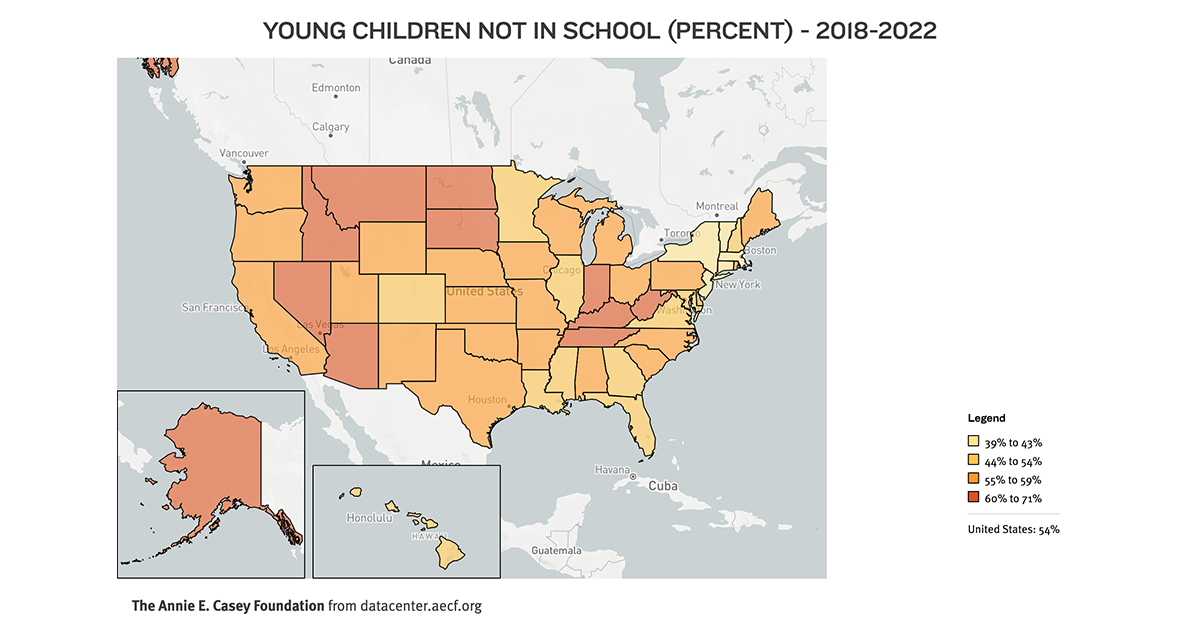Preschool Enrollment Remains Below Pre-Pandemic Levels, While Uneven Access and Quality Persist

As children across the country settle into the new school year, a concerning national trend remains true: Over 50% of America’s preschool-age kids are not in school, and enrollment remains below pre-pandemic figures, according to researchers.
Early education programs are invaluable in preparing children for elementary school. Such programs are associated with improved academic achievement and emotional and physical health. Preschool also plays a key role in reducing academic and health disparities by socioeconomic status and race. Yet, access to high-quality early childhood education is limited for many Americans — especially low-income kids, children of color, those with English as a second language and children with disabilities. Further, while Head Start and the expansion of state-funded programs in recent decades have substantially improved preschool access, many children (particularly 3‑year-olds) continue to be left out.
The Latest Findings on Preschool Enrollment
More than half (54%) of the nation’s 3- to 4‑year-olds were not in preschool during 2018–2022, according to the KIDS COUNT® Data Center. The share of young kids who didn’t attend any preschool program — representing 4.3 million kids — has increased by two percentage points since 2013–2017, consistent with other findings that preschool enrollment remains below pre-pandemic levels.
The KIDS COUNT Data Center also tracks enrollment in the public Head Start program, which showed an increase in 2022 after a steep drop in 2021. Specifically, among U.S. children ages 3 to 5 in Head Start, enrollment rose by 5% in 2022 — from 513,320 in 2021 to 538,496. This total is still far below the 712,350 kids enrolled prior to the pandemic in 2019. As researchers put it: The “pandemic erased a decade of progress in preschool enrollment in state-funded preschool programs, preschool special education, and Head Start.”
Limited Access to Preschool Is Not a Recent Problem
Children’s access to preschool differs by income, race and ethnicity, immigrant status, language background, disability status, geography and other factors, as indicated by decades of research. When parents seek to utilize child care or preschool, they often struggle to find high-quality, affordable and available options, and these challenges are exacerbated for families from historically marginalized communities.
Contributing to this challenge is the fact that very few states offer free, public preschool programs starting at age 3, and only a handful meet minimum quality standards. America’s early education and child care systems are also chronically underfunded, and this issue is exacerbated by widespread staffing shortages in the field.
Explaining the Terms: Preschool, Early Childhood Education and Child Care
Experts generally use the term “preschool” to describe a broad range of early care and education programs for children ages 3 to 5, including those in family child care settings. These can be privately or publicly funded programs, such as Head Start and state-funded programs.
The data in this snapshot is based on a narrower definition of preschool. The KIDS COUNT Data Center defines“preschool” as educational experiences offered in a group or class setting prior to kindergarten, including public or private programs. Children in private homes that primarily provide custodial care are not included.
The umbrella term“early childhood education” (ECE) describes a variety of developmentally appropriate care and educational programs offered from birth to kindergarten, including preschool. ECE can be offered in a number of settings, such as homes, schools, child care facilities and faith-based institutions.
“Child care” describes a spectrum of care that starts with infant care and includes comprehensive ECE programs. This care may be center-based or family home-based and delivered formally or informally. School-aged programming that is offered before school or after school is also considered child care.
High-quality programs — whether preschool, ECE or child care — involve highly-skilled staff providing evidence-based care and learning opportunities in developmentally, culturally and linguistically appropriate ways. These programs support the health of the whole child, including their emotional and physical well-being, and include strong family engagement, among other aspects of quality.
Read more about the child care system and why it matters in the KIDS COUNT Data Book
Persistent Barriers to Preschool for Low-income Kids
The KIDS COUNT Data Center tracked preschool enrollment by family income level for more than 15 years — from 2005 to 2022 — and the findings are abundantly clear: Children from low-income families are less likely to access preschool compared to kids from higher-income families. Over the entire period, approximately 60% of low-income kids did not attend preschool, while only 45% to 50% of higher-income kids missed out on this opportunity.
The latest data from the National Center for Education Statistics revealed similar access disparities by income level as well as by parent education level. For instance, in 2022, U.S. preschool enrollment rates among children ages 3 and 4 were:
- 39% for kids living below the federal poverty level, compared with 52% for those living above 185% of the poverty level.
- 32% for kids living in households where no parent had completed high school, almost half the share (57%) of those living with parents who had at least a bachelor’s degree.
These findings echo a large body of research demonstrating that children with socioeconomic disadvantages have less access to high-quality early learning programs and face more barriers to academic achievement in general. Other groups facing similar barriers include children of color, immigrant children, English-language learners and children with disabilities. Access to early education also varies depending on where children live.
Additional Preschool Enrollment Findings by Race and Location
By race and ethnicity:
- In 2018–2022, participation rates by race and ethnicity showed that, for children ages 3 to 4, Latino, American Indian or Alaska Native and multiracial kids were less likely to access preschool compared to their white, Black and Asian and Pacific Islander peers. This range — describing the share of kids not in preschool — ran from a high of 61% for Latino kids to a low of 52% for white and Asian and Pacific Islander kids, according to the 2024 KIDS COUNT Data Book.
- However, when data for Pacific Islanders were separated from Asians, the National Center for Education Statistics found that Pacific Islander children ages 3 to 4 were the least likely to attend preschool of any racial or ethnic group, with only one in four enrolled in 2022.
- From 2017–2021 to 2018–2022, the share of kids not in preschool increased slightly for American Indian or Alaska Native (58% to 60%), Black (52% to 53%) and Asian and Pacific Islander (51% to 52%) kids, according to the KIDS COUNT Data Book. Figures for Latino, white and multiracial kids remained even.
- Putting these findings into context, a 2024 consensus report by the National Academy of Sciences summarized existing research and found that racially and linguistically marginalized children consistently have more difficulty accessing preschool—particularly high-quality programs. According to the report, when kids of color are able to access preschool, “even within programs, children from these communities often experience markedly lower-quality education compared with their white, higher-income, and native English-speaking peers.” High-quality programming is critical to achieving the benefits of early education.
By region and state:
- In 2018–2022, kids ages 3 to 4 in the nation’s Western, Midwestern and Southern regions were less likely to access preschool relative to their Northeastern peers. This range — describing the share of kids not in preschool — runs from a high of 57% in the West versus a low of 45% in the Northeast.
- Also from 2018–2022 but at the state-level: The share of kids missing out on preschool varied widely, from lows of 22% in D.C. and 39% in Connecticut and New Jersey to highs of 71% in West Virginia and 70% in North Dakota. In 11 states across the nation, more than 60% of children ages 3 to 4 were not in preschool.

- Access to early education programs is a particular challenge in rural areas, with some estimating that rural preschool enrollment is about half the rate in urban or semi-urban areas, according to a 2023 National Academy of Sciences report.
- Looking at trends over time, 36 states and D.C saw preschool enrollment rates fall between 2013–2017 and 2018–2022, ranging from slight declines of one percentage point to larger drops of seven points.
Taking Action to Improve Preschool Access and Quality
Early childhood is a critical period of development, and experiences during this phase lay a foundation for long-term health and well-being. The limited and inequitable access to high-quality preschool is especially alarming given the following:
- quality early childhood education is strongly linked to later student success and positive health outcomes;
- the nation is already facing an education crisis, with students less likely to reach academic proficiency after the COVID-19 pandemic and with academic disparities by race and income level persisting;
- kids who can benefit the most from early learning programs are the least likely to access such programs; and
- early childhood education improves school readiness, and students who enter kindergarten behind their peers may struggle for years to catch up.
Many parents rely on preschool and child care programs in order to work. When families have access to affordable, high-quality early childhood education, both kids and their parents benefit. And by enabling parents to work or go to school, these programs also have broader benefits for communities and the economy. Prioritizing equitable access to such programs is essential.
Experts recommend a range of actions to bolster access to quality programs, including:
- committing long-term federal funding — commensurate with the estimated cost of quality programs and the cost of reaching all eligible children — to stabilize and strengthen the early childhood education infrastructure;
- expanding the federal government’s work with states to fully realize universal high-quality public early education, which would reduce inequities by geography and address gaps in opportunity, as described by the National Academy of Sciences;
- ensuring that preschool quality standards and curricula are updated based on evidence and that they prioritize equity, considering the needs of children of color, English learners, children with disabilities and kids living in poverty;
- increasing state and local investments in preschool programming to expand access and improve quality, as outlined by the National Institute for Early Education Research;
- increasing the supply of high-quality, affordable child care, such as providing grants to providers, investing in teacher wages or benefits, bolstering professional development efforts and other innovative solutions; and
- across all federal, state and local programs, prioritizing reaching children who could benefit the most from early childhood education and children who are disproportionately underserved.
More Resources Related to Early Childhood Education
- 2023 KIDS COUNT Data Book
- 2024 KIDS COUNT Data Book
- The State of Preschool Yearbook 2023
- A New Vision for High-Quality Preschool Curriculum
- Overdue: A New Child Care System that Supports Children, Families & Providers
- Child Trends: Access to Child Care and Early Education
- National Association for the Education of Young Children
- Child Care Aware
Preschool and child care indicators on the KIDS COUNT Data Center:
- Young children not in school
- Young children not in school by poverty status
- Head Start enrollment by age group
- Households with child care arrangements disrupted by the COVID-19 pandemic
- The pandemic’s impact on child care disruptions and adult employment
- Households with kids unable to access daycare or child care due to the pandemic
- Employment impact on adults living with kids who could not access daycare or child care due to the pandemic
Sign up for our newsletters to get the latest data, reports and resources






